Is your checkout system ruining your conversion rates?
Have you ever had the feeling that your eCommerce website is ticking all the right boxes for Google AdWords conversions, yet somehow you are still missing out on sales?
Imagine it, you have a strong PPC campaign with conversion driven landing pages and most importantly, the products themselves are fabulous but customers are abandoning their shopping carts at the last minute.
It can be frustrating for PPC advertisers and e-commerce site owners alike, having followed best practice PPC tactics, to have the customer give up halfway through checkout. You would think that having clicked on an ad, browsed your merchandise, added to cart and even committed to starting the payment process, that purchase was inevitable.
This is an extremely prevalent problem with a troubling 68.63% of customers abandoning their products in the cart. Kissmetrics even claim that most shoppers are not making it past the first stage of the checkout process, as you can see from their chart’s data below:
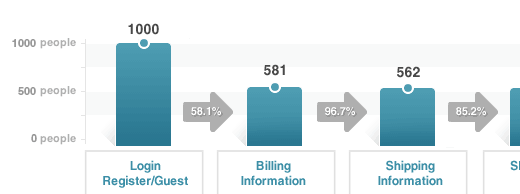
If you are suffering from low Google AdWords conversions due to a severe case of shopping cart abandonment onsite, then it may not be your PPC campaign or even your landing page that is at fault. Instead, the checkout system itself could be ruining your conversion rates.
As online shopping has become increasingly common in society, e-commerce websites have become very important for retailers. UX and CRO specialists have undertaken a great deal of research and testing over the last few years to get to the bottom of shopping cart abandonment. Some clear patterns have emerged that show the major reasons users abandon their occupied shopping carts.
As you can see from the Usability Geek chart below, checkout systems are to blame for at least 12% of lost conversions and many of the other top reasons are related to dissatisfaction with aspects of check out as well:
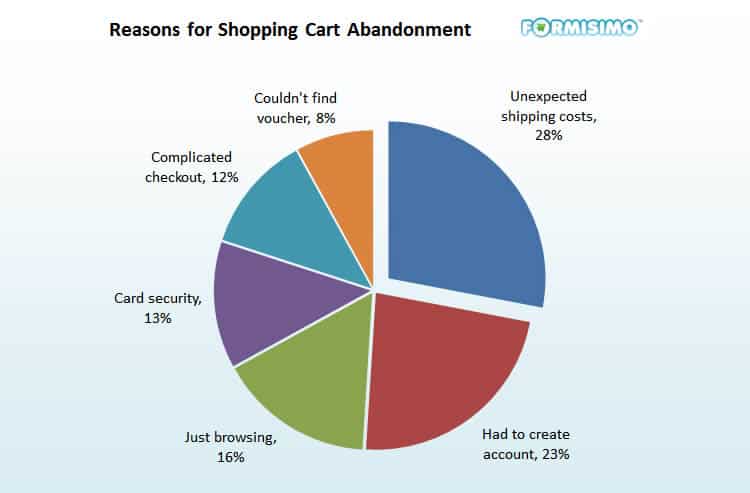
This insight is not only understood in the digital marketing community, even well-known business insights publication Business Insider have reported on the findings:

Despite this knowledge, online retailers are still struggling to solve the problems and raise their conversions rates.
If you have reviewed your eCommerce site data and your AdWords campaign and suspect a causal link between shopping cart abandonment and your low conversion rate then the problem is likely your checkout system and there are 4 core areas you need to address.
- Time wasting
- Lack of trust
- Money
- Poor mobile experience
Nearly all fundamental issues with your checkout system can be grouped into these problem areas. Understanding how issues with your checkout system affect your customers negatively is your first step in solving the problem and improving your Google AdWords conversions.
Wasting customers’ time
When customers click on your ad and like what they see on the site they want to buy quickly. The modern age of technology has produced some very impatient people with short attention spans and you need to acknowledge this mentality when designing your checkout system. Buying online is part need and part impulse, depending on the product, yet slow checkouts that rob users’ free time are always going to make customers think twice. Even those committed to your product could get distracted in the process.
To stop wasting your customers time you should:
- Keep fields to a minimum in the checkout – Lots of questions may help your data or provide a more personalised shopping experience but unfortunately most users just want to buy and get out of there. They choose online buying for convenience, so to enable a more streamlined experience, avoid additional fields unless they are 100% necessary.
- Ease frustration with progress bars – Progress bars are one of the best things to happen to checkout systems. The fact remains that you cannot cut everything out of the checkout system. In most cases, you will at least need an email and billing information. If it’s a product to be delivered, not just downloaded, you end up with even more necessary steps. By adding a progress bar, you can placate your impatient customers. You are letting them know where are they are in the process and how close to finishing. You can also use color in your progress bar to indicate active and non-completed steps.
Here are two examples of simple but highly effective progress bars to ease customer impatience:
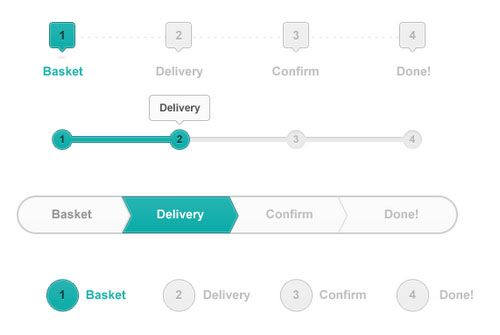

If you are a company producing custom product orders you are probably going to have more fields and therefore a longer checkout process. By adding a progress bar for the order and payment, plus tracking on whether the product has been created and posted yet, you will enhance excitement and dissolve some of the frustration.
- Beware of slow loading checkout systems – It isn’t just too many fields that make a checkout system slow. You need to check the loading speed of each section of your checkout system. If customers get bored waiting they will leave.
Studies show that about 44% of customers will abandon their products if pages take too long to load. This impatience is further exaggerated if they are on mobile or tablet. According to Crazy Egg’s research, 85% of mobile users expect checkout pages to load as fast or faster than on desktop.
You can review your checkout pages’ speed using Google page speed insights. Removing social and third party scripts and graphically intense objects is a good way to cut download time. You should also frequently stress test your checkout page in an effort to simulate high traffic periods. Your site will hopefully increase in popularity over time and receive greater traffic, so don’t just carry out stress tests once but periodically as part of your ongoing site maintenance.
- Under absolutely no circumstances should you enforce users to create an account to buy – We cannot stress enough that forcing account creation is one of the biggest reasons for users not converting when they reach checkout. People are pressured to have accounts for everything these days but really no one wants to spend the extra time creating them or having to memorize yet another password. Always allow for guest checkout. In their study of e-commerce statistics, Kissmetrics found 23% of users will abandon their shopping cart if they have to create a new user account.
- Resist captcha forms – Wanting to reduce spam is understandable but not to the detriment of your Google AdWords conversions. Captcha forms can be annoying, time wasting and hard for customers to read. Moz carried out some fascinating case studies which revealed that having a captcha form could increase failed conversions. The case study had a 3.2% potential loss of conversions with captcha switched on, so consider if it’s worth the loss of business.
- Resist bombarding customers with too many reward choices – Freebies, coupon codes and extra offers during checkout are a great way to entice conversions…….as long as you don’t take it too far and clutter up your checkout system. If you are in a hurry and just want to buy, too many choices can deter you. Urban Decay is one example of a company who take it a bit too far with all the samples when you are in a hurry. Users have to select 3 or sometimes more samples, previously from a carousel of many products, as well as navigating past coupons and sign up offers. Sometimes you just need to get your makeup and go. A couple of free samples are fine but don’t go crazy.
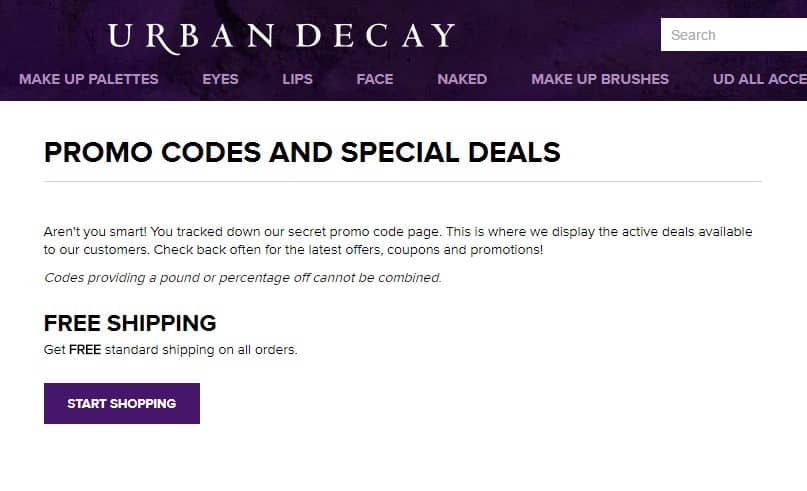
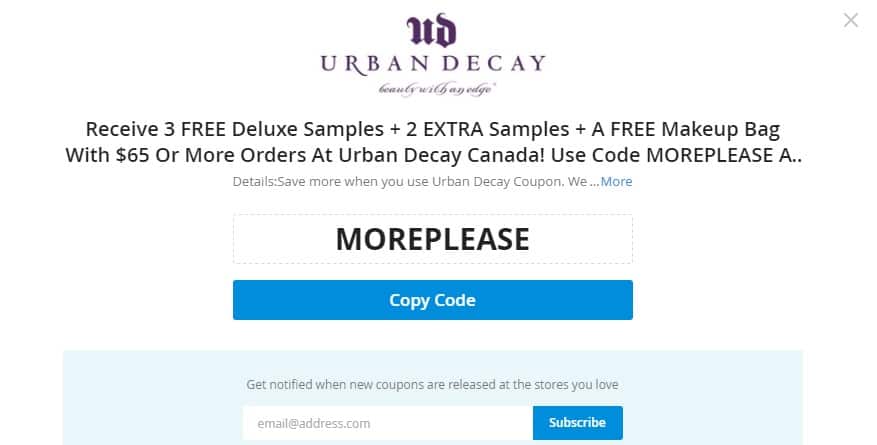
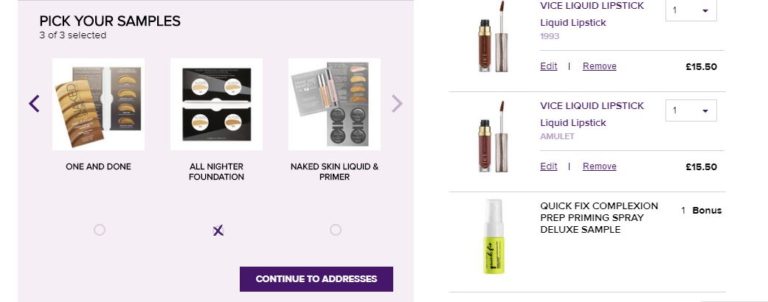
- Help users if they get stuck – You can have a marvelous checkout system but due to good old fashioned confusion or a technical bug sometimes customers might still get stuck.
If you are on hand to quickly answer a question or solve a fault you can still make that conversion happen. Investing in a live chat option, along with a click to call button is a good plan. Don’t forget to add call tracking to your AdWords campaign to catch those micro conversions.
- Keep delivery time short – If you are searching for a gift for a birthday or special occasion and the estimated delivery time is too long you are likely to abandon the item. Overly long estimated delivery times are a big turn off in your checkout system. Unless it is a bespoke order, try your best to be efficient and offer the option of increased charges for faster delivery, next day and named day delivery if possible. No amount of freebies will get the conversion back if you can’t make that birthday deadline. Quoting long delivery times is the way to lose business to Amazon but if you want to ease some of that delivery tension use progress bars again, along with tracking and email reminders. Amazon already provides great reminder emails of dispatch and progress bars for tracking.
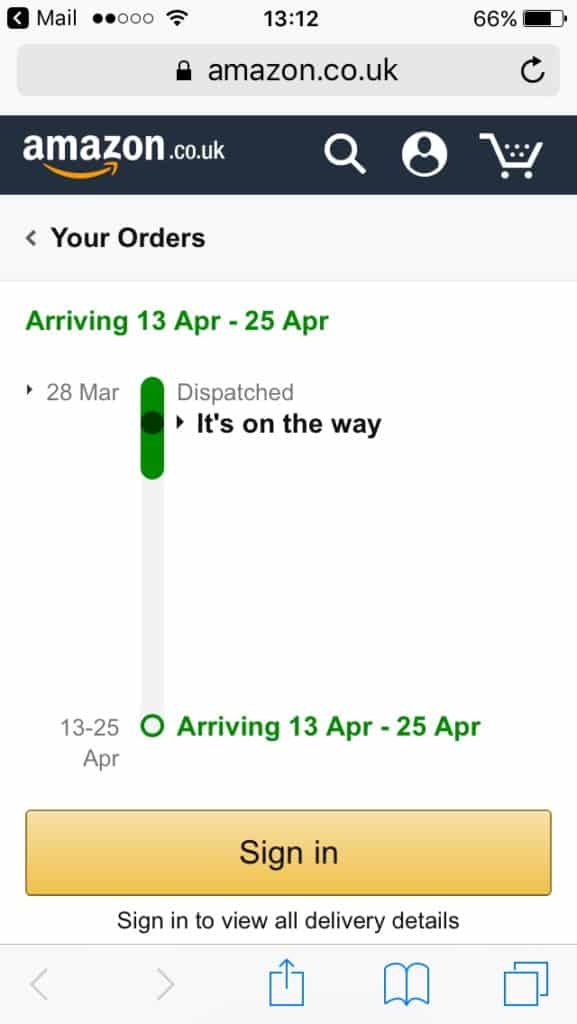
Failing to instill trust
Another major area that checkout systems can ruin is trust. Trust is so important for your relationship with customers and you need to instill trust even more with online customers. Customers cannot view, hold or try on the product in real life, so there is a lot of trust required in an online purchase. Any element of the checkout process that even hints that trust may have been misplaced will send customers running. Follow our expert advice in building customer trust during the online checkout process:
- Use recognised security badges – A security badge from a well-known regulator at checkout can help reduce customer anxiety at first contact with an online store.

- Always style your checkout to match your site – Differently styled checkouts usually happen when you are utilizing a third-party checkout system like PayPal. This can mean an ugly checkout system, small font or even just one unconnected to your brand. This can put less experienced online customers ill at ease. Sometimes third-party checkout systems will offer an option styled like your site for greater cost. It is also a good argument for having your own payment checkout designed in house.
- Use previous customers’ reviews – By featuring fantastic reviews of specific products from previous happy customers, you will easily encourage greater trust. 55% of shoppers say that online reviews influence their buying decision.
- Make your intentions clear to elevate justified paranoia – What do we all hate? Sales and research calls. When do we hate them? Pretty much consistently. Customers are historically suspicious if you ask for their phone number, especially if they are relatively new to online orders. They are suspicious that you are going to bombard them with sales calls, so if a mobile number is a required field explain to customers that you require it for delivery updates only.
- Always have card payment options – To save money some small online shops will only use third party payment tools like PayPal. This is a mistake because it requires the customer to already have a PayPal account or to set one up. Most customers want to be able to pay by debit or credit card directly. We would always advise allowing payment by the most popular cards (Visa, Mastercard, American Express) in addition to systems like PayPal. Integrating your website with branded and hosted online payment solutions offers credibility and a seamless, speedy checkout experience. If you are planning to allow card details entered directly into your website make sure you are PCI compliant. For more advice on payment gateways take a look at this helpful article.
- Have multiple third-party payment options – While some customers will prefer to enter their card details, other safety conscious individuals will want the option of their preferred third-party system. While PayPal is highly reliable and popular there are several other very popular systems too, such as Stripe, Amazon Payments, Google Wallet and Apple Pay. Try to give customers the option of their preferred system. Learn more about the top PayPal alternatives in this article before choosing which to allow on your e-commerce site.
- Avoid having the checkout on a different domain – Again, this is often a problem that occurs with only allowing third-party checkout systems such as PayPal. One of the worst practices is redirecting your customers to another website for payment. Some customers may mistakenly think it is a bug or scam if they notice the domain change. It is always best to avoid this unnecessary friction and it’s better for your tracking.
- Ensure your e-commerce trading name matches the company to be paid on checkout confirmation – If your website is using a trading name rather than your officially registered business name, you need to make sure there is consistency throughout checkout. If you were to sign up to PayPal or any other system with your official business name and then brand the e-commerce site under a different trading name, you could end up with a different business name referenced in the checkout. This will definitely arouse suspicion and unease in some buyers. Some will once again suspect a scam. Always ensure your business name is consistent in all checkout forms or that it is clearly stated that the e-commerce site name is a trading name of your official business.
- Have a returns policy – If your e-commerce business lacks a returns policy for physical items or a money back guarantee for dissatisfaction with digital programs, customers may be less willing to purchase from you. They are taking a risk and want to know they are getting value for money. Products can also arrive damaged in transport. Although returns and refunds are costly, not having a returns policy could lose you conversions and foster a less positive customer relationship.
Failing to be good value or financially convenient
While speed and trust are very important in a positive checkout experience, naturally the biggest barrier to conversions is always money. Money is the root issue with e-commerce conversions. Your business is trying to make money and your customers want to save as much money as possible or at least feel the item is worth what they paid. Hidden costs during the checkout experience are a central cause of lower conversions.
- Be upfront about cost – According to Business.com, 61% of shoppers abandon their carts because additional costs are too high and an additional 24% abandon because they couldn’t see the entire cost upfront. If delivery or international shipping will add to the cost of the product this should be immediately apparent when browsing products not half way through checkout. If you hide costs, customers feel manipulated.
- Help those with poor maths skills – Not everyone is born equally blessed in the mathematical department but these individuals still need to buy things.
It shouldn’t matter to you how gifted at basic numeracy your customers are, they can still be a valuable customer and provide profit to your business. In fact, their poor numeracy may in many ways make them a better customer. Therefore, you shouldn’t punish them but help them.
Impulsive buyers and those who don’t naturally start calculating cost in their minds might add several products to their cart that all seem individually reasonably priced. Unlike other shoppers, they may not have considered the total cost because their recognition of the relationship between numbers is poor.
When they get to the checkout and see total cost it may come as a bit of a shock but instead of removing a few items they feel thwarted and give up. By displaying clearly the total cost, as it adds up while the customer shops, you can help these customers remove an extra item before starting the checkout process. You may not receive the big payment all those products would have accrued but you get the conversion rather than losing some and your customers will appreciate it.
- Offer free shipping – Any savings you can offer a customer will encourage conversion. Even if you can’t offer completely free shipping, consider free shipping if they spend over a certain amount.
Design for mobile users
Mobile now accounts for 50.3% of all e-commerce traffic. However, as we reviewed in Perth Web Design’s recent Google Shopping article, conversion rates on mobile continue to lag significantly behind desktop for the retail sector. This is partially because e-commerce sites are not doing enough to design checkout systems for mobile users. Just being responsive isn’t good enough, designers should be looking at the mechanics and experience of a mobile user to make checkouts less complicated. By accomplishing checkouts designed for mobile we reduce the need for cross-device conversions, forgotten baskets and your Google AdWords conversions should increase.
Consider the way users hold their mobile device when browsing the internet to help designers produce a better experience. The following diagram shows the top 3 ways we hold mobiles when browsing online, according to research by UX Matters:
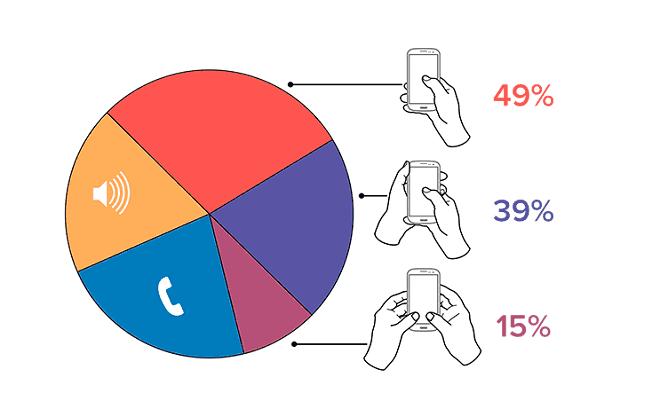
Although two handed use might seem easier for operating a mobile device during checkout, the research shows only 15% of mobile users use two hands.
When designing for mobile pay attention to how the thumb joint must stretch to click regions of the page when browsing in the top 3 positions. You want to put your priority buttons for both CTAs and essential buttons in checkout in the easiest to reach places. The diagram below shows which areas are easy to click, which are a stretch and which are physically uncomfortable:
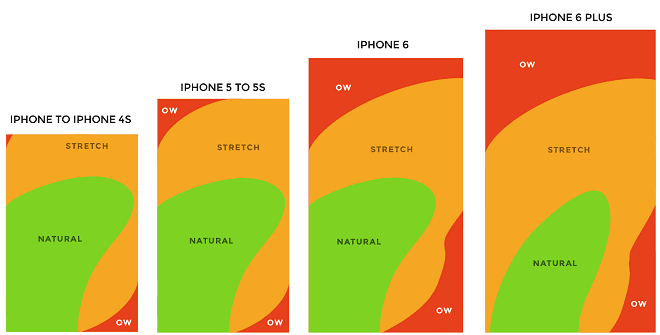
When displaying essential information during checkout you also need to consider how fingers and thumbs obscure the screen accidentally. Avoid putting important elements in the corners of the screen. On-screen keyboards also take up space during the checkout process when users must add info to fields, so it is important to keep the design minimalist and clear. This is also why fewer fields and keeping text input to a minimum is useful.
The following tips should help fine-tune your checkouts for mobile.
- Bigger is better for fields on mobile – By having larger fields you make it easier for customers typing in their details by thumb, finger and touch screen. Using a thumb is much harder than a full keyboard and mouse and it is easier to make mistakes but larger fields can mitigate this somewhat.
- Use wide buttons – Again, it is important to acknowledge that fingers are fat and clumsy for the world of tiny touch screen buttons. Users accidentally adding items to the cart is not unheard of in the mobile world. You can easily click a button when trying to scroll, therefore make it easier with larger full view length buttons. Also, don’t clutter browsing areas with too many unnecessary buttons. Focus on buttons that drive real conversions like ‘Buy Now’.
Make buttons in the checkout system especially easy and simplistic. Regular experiments with the size and position of buttons should help to hone the mobile checkout experience.
- Used stacked design – Placing each required field, button or action on a separate row with ample breaks reduces mistakes in checkout for mobile users.
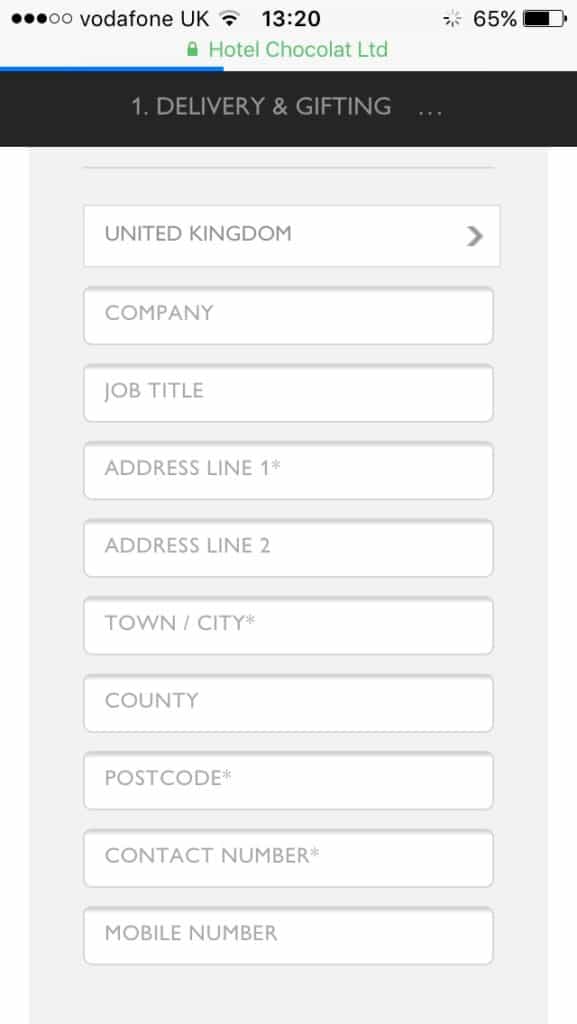
- Use multiple pages in checkout – While the checkout system should be short and streamlined, it is a bad idea to cram too many items on the one page for mobile users. Segregate the necessary sections onto separate pages to avoid a long scrolling page. Try to avoid scrolling and potentially missed fields at all costs and keep essential fields and buttons in central areas for easy thumb reach.
Amazon provides a perfect example with their checkout:
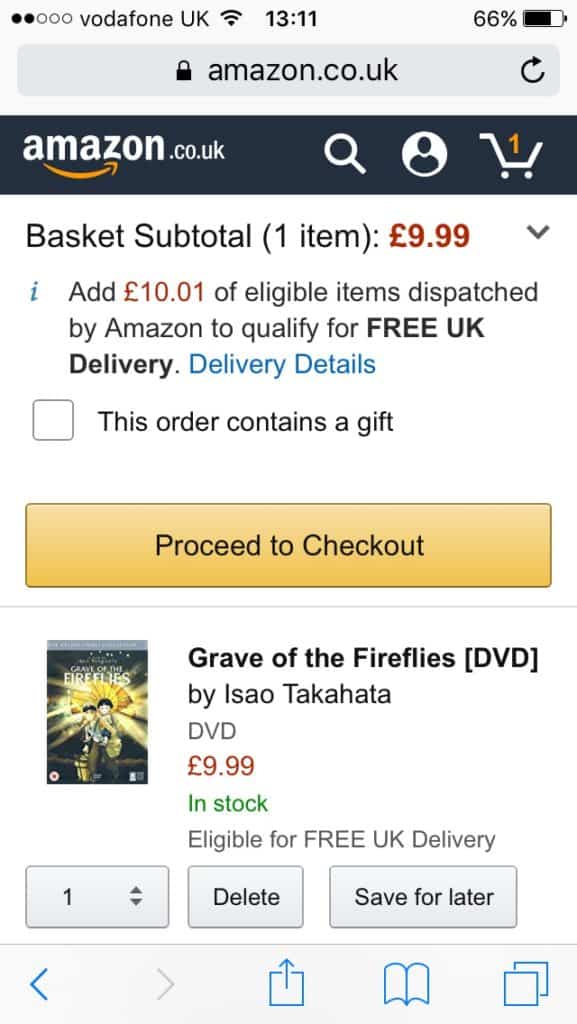
While Etsy’s checkout is also not bad, you need to scroll through two pages and buttons are smaller, making Amazon the clear winner at mobile checkout design.
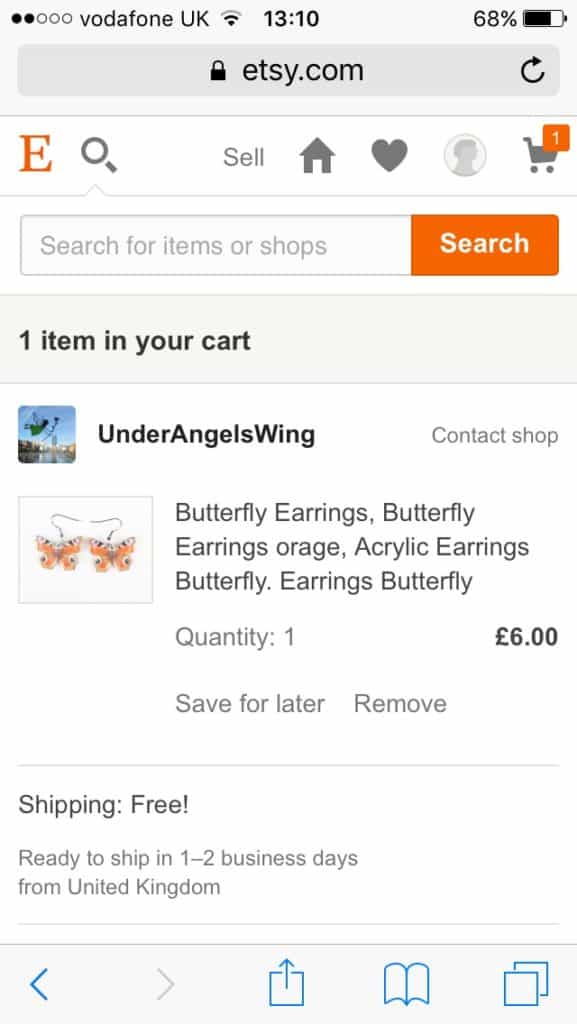
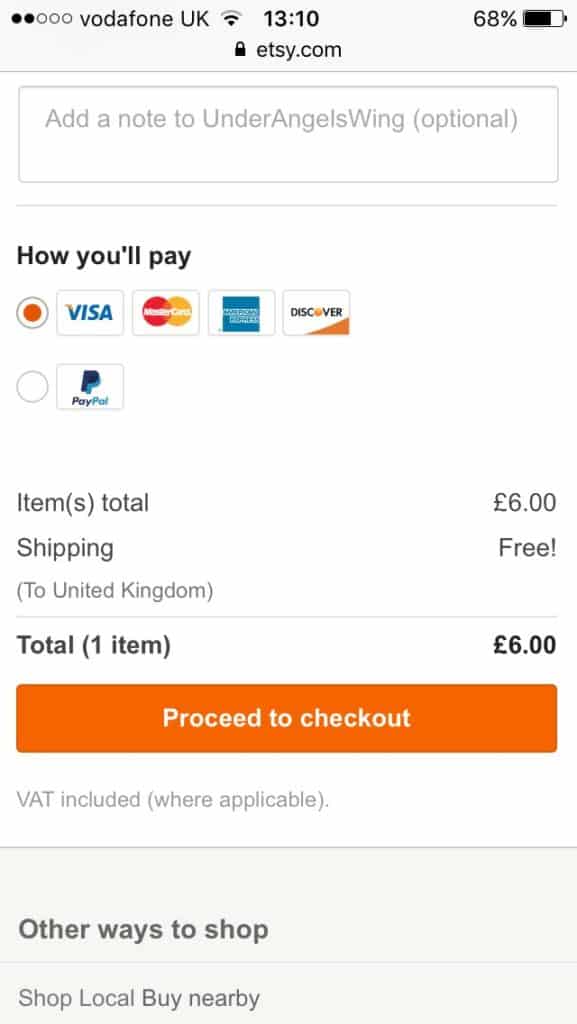
- Use the numeric keypad for entering phone numbers and card numbers – The alphabetic/numeric keypad that normally displays for mobile users filling in their card details is tricky. The buttons are small and it is very easy to enter the wrong number in your card details. You can easily code your checkout system to generate the purely numeric keypad (the one seen when you dial a phone number) when users reach a card or phone number field.
In the diagram below from UXBooth, you can clearly see the number keys are bigger on a purely numeric touchscreen keypad:

The Baymard Institute provide some helpful tips on implementing the numeric only keypad for the correct fields, along with examples and other HTML tricks to make fields easier for mobile users. Get your designers to have a quick browse of their suggestions for a better mobile friendly checkout system.
Would you really put up with this in a real-life shop?
If you own an e-commerce site and you are trying to raise your Google AdWords conversions it can sometimes feel like customers are getting a little spoiled but really the key to a great experience is to put yourself in the customers’ shoes.
We are all customers sometimes. It doesn’t take much to realise why some of these time-wasting elements and extra costs are such a pain. If you need a little inspiration we highly recommend you take a look at this hilarious video from Google Analytics. It reveals what it would be like if shopping in a store was like a poor online checkout experience:
www.youtube.com/watch?v=3Sk7cOqB9Dk
Other tips to force those conversions
By solving the outlined problems, you will be able to improve your checkout system and increase those Google AdWords conversions for your e-commerce business. Naturally, retailers who want to go the extra mile won’t just focus on solving core problems but look to enhance all aspects of the checkout experience to outmaneuver competitors. Here are some simple tricks for a really polished checkout system.
- Colored buttons for high priority actions – When you have multiple buttons for different buyer options you need to make them visible and easily differentiated. By using more prominent colors for high priority actions, such as ‘proceed to checkout’ and paler button colors for actions like ‘continue shopping’ you will aid your customers and encourage faster conversions.

- Allow persistent shopping carts – Sometimes users run out of time before they can finish the checkout process and sometimes they are just researching. Most online shopping baskets time out and clear too fast. By allowing persisting shopping baskets you increase the chances users will come back and finish the purchase later. Allow persistence for up to 30 days. Users may have wanted an item then thought to wait until payday. Using wish lists is also a fun trick to tempt those researchers.
- Use psychological temptation – Always ask yourself what you could have done to entice users to make that purchase if there was any doubt in their mind. Make sure you use high-quality product images and display items from different angles. While you shouldn’t clutter the checkout system with too many offers and choices, a little extra incentive can go a long way. Everyone loves free gifts. Try CTAs like ‘buy in the next 10 mins before stock runs out’ or ‘get 20% off’.
- Create urgency – Having low stock signs or how many items are left in stock will encourage users not to abandon products as easily. Hotels.com use this psychological pressure frequently.
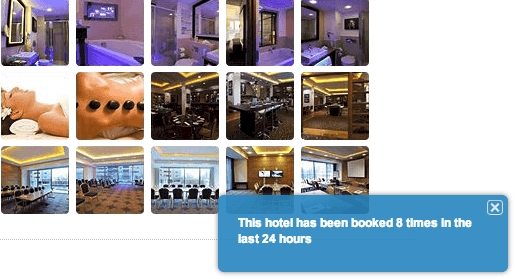
- Retargeting – Retargeting with display ads, RLSA ads and best of all reminder emails is an ideal way to remind customers that they abandoned their products before completing checkout. Retargeting emails combined with persisting shopping baskets have been proven to aid conversion rates. eCommerceFuel reported monthly recovery rates for abandoned products between 3 and 11% after using retargeting emails. Radley London, a UK accessory store, recovered 7.9% of lost sales after sending cart abandonment emails.
- Embrace emerging technologies – Companies with sufficient funds should try to embrace and invest in emerging technologies that will improve the checkout experience further. Customers are more impressed when you are the first in your industry to improve their experience. Soon, people may not even need to enter card details as card scanning technology improves.
The best improvement you can make to your check out enhancement strategy is to review the experience from the customer perspective regularly. Continually test and analyse data in analytics to identify problem areas and never get complacent. No checkout system is ever perfect, there will always be room for improvement.
